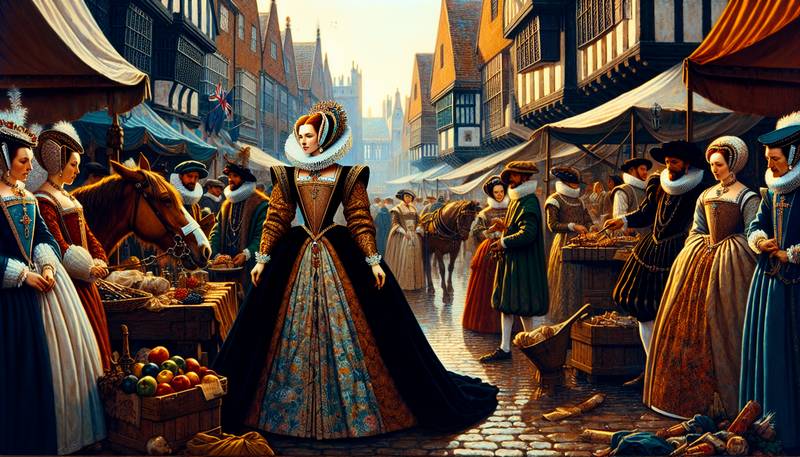Tudor Ruffs and Farthingales: 16th Century Court Attire

A Brief Introduction to the World of Tudor FashionPicture yourself in a crowded London street during the 16th century, the air is thick with the scent of horse dung and the cacophony of shouting market traders. Suddenly, a vision of elegance and refinement emerges from the mire - a noblewoman swathed in sumptuous fabrics, her waist cinched into an impossibly small circumference by a device known as a farthingale. Her neck is adorned with a frilly confection, the famous Tudor ruff. Yes, ladies and gentlemen, we have been transported to the world of Tudor fashion, where the most fashionable attire was not only eye-catching but impractical and, at times, positively hazardous to one's health.Tudor Ruffs: An Accordion of Lace and StarchFirst things first, let's talk about ruffs. These elaborate neckpieces were all the rage in the 16th century, adorning the necks of both men and women in courtly circles. They varied in size and complexity, from modest designs worn by the lower gentry to extravagant creations sported by the likes of Queen Elizabeth I herself. But how, you may ask, were these intricate confections of lace and linen made?Well, my dear inquisitive reader, the secret lies in the application of starch. This simple yet crucial substance is derived from boiled wheat or potato and possesses the magical ability to transform limp fabric into a stiff accordion of frills. The fabric was first carefully cut and pleated before being soaked in a vat of the finest starch and left to dry, emerging in a form that would make even the stiffest of collars quiver with envy. It's worth noting, however, that the process of starching could be a rather malodorous affair, as the concoction would often be left to fester in the sun for days, producing a stench that would make even the most hardened nose wrinkle in dismay.A Ruffian's Guide to Wearing a RuffNow that you're suitably acquainted with the process of starching your ruff, it's time to discuss the practicalities of wearing such a magnificent accessory. For starters, you'll need assistance - after all, it's no simple task to secure a mountain of fabric and starch around one's throat. Indeed, it's likely that the wearer would have required the services of a maidservant or page to fasten the ruff in place with a series of strategically placed pins.Once your ruff is securely fastened, you'll quickly discover that mobility is somewhat limited. Turning one's head becomes an impossible task, as the ruff forms an unyielding collar that encircles the neck like a decorative brace. Sneezing and coughing must be executed with the utmost caution, lest you dislodge the entire structure or, even worse, propel a mouthful of phlegm into its delicate folds. In short, the experience of wearing a Tudor ruff is not unlike that of a swan trapped in a particularly unyielding tutu.Farthingales: The Tudor Answer to the Hourglass FigureMoving on to the lower half of the body, we have the farthingale - a device that, when combined with a tightly laced corset, produces the highly desirable (and uncomfortable) silhouette of an inverted cone. Farthingales were typically made from a series of hoops, fashioned from whalebone or willow and connected by horizontal strips of fabric. The resulting structure was then covered in a voluminous skirt, which was stiffened with additional layers of fabric or padding to create a dramatic, bell-like shape.How to Walk in a FarthingaleHaving donned your farthingale, you may be wondering how on earth you're supposed to navigate the treacherous environs of the 16th century court. Fear not, for I have some sage advice to impart. Firstly, you'll need to adopt a wide-legged stance to accommodate the prodigious girth of your skirt. Should you encounter a narrow doorway or corridor, simply turn sideways and shuffle through with all the grace and dignity you can muster. When it comes to ascending or descending a flight of stairs, be sure to enlist the aid of a sturdy banister or the arm of a gallant gentleman to avoid toppling headlong into an ignominious heap of fabric and hoops.The Perils of Tudor FashionAs thrilling and glamorous as it may be to swan around in a ruff and farthingale, it's worth remembering that these fashions were not without their dangers. The weight and restrictive nature of the garments could lead to all manner of health problems, from respiratory issues to fainting spells. Furthermore, the abundance of fabric and starch made for a highly flammable combination, with numerous instances of courtly ladies (and gents) falling victim to the perils of open fires and candles.Nonetheless, the allure of the Tudor ruff and farthingale is hard to resist, and their enduring appeal serves as a testament to the enduring fascination with the fashions of this remarkable period in history.
|
|








